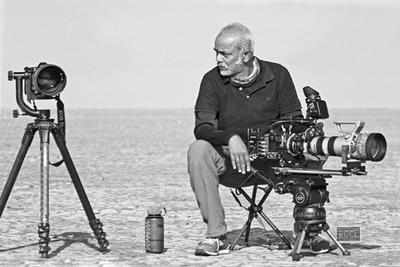- News
- entertainment
- hindi
- bollywood
- Nalla Muthu: We can do a much better job than international filmmakers
Trending
This story is from April 18, 2015
Nalla Muthu: We can do a much better job than international filmmakers
Wildlife filmmaker Nalla Muthu began his career by filming ISRO's rocket launches on his high-speed camera, but soon focussed his lens on subjects far less predictable.

Wildlife filmmaker Nalla Muthu began his career by filming ISRO's rocket launches on his high-speed camera, but soon focussed his lens on subjects far less predictable.
His films on Sariska and Ranthambore's tigers have won him widespread acclaim and in 2012, Tiger Dynasty, which chronicled the relocation of the tigress Baghani to Sariska, whose tiger population had been wiped out, won the National Awards for Best Cinematography and Best Environment Film.
This year has brought him his third National Award, that of Best Exploration Adventure film, for Life Force: India's Western Ghats. Unlike others who wear both hats, he doesn't mince words "I am not a conservationist or a scientist, I am a filmmaker."
He doesn't want to brood over India's notoriously sluggish 'wildlife bureaucracy' either, and thinks the country has great potential because "Africa has been done to death."
In a conversation at his Noida office, he tells us about shooting his latest building machaans 40 feet high and brushing off leeches at closing time why he took a break from his biggest selling star, the tiger, and why nature films in India need to listen to Modi's 'Make in India' call.
Your best known works are the Tiger trilogy. The cause of the tiger is being endorsed by big celebrities, it's very 'sexy' to say 'save the tiger' today. For Life Force, what made you move away from the biggest selling star of Indian wildlife, to the not-so-popular Lion tailed Macaque, Great Indian Hornbill, Slender Loris and Purple Frog?
Obviously , the tiger sells it's a charismatic animal and only India and a few other Asian countries have it. So, there's always a big demand for tiger films. I'm not specialised, but yes, I have been filming only tigers for the last 10 years.
But I did this film for a change, and it's a big challenge filming species like these.They're small, but a lot of things about them have never been filmed. That was our main purpose. It was just two or three years ago that scientists came out with photos that confirmed the Purple Frog still lives in the Western Ghats.
We are the first to film their mating sequence, which we got after 25 days of waiting. We filmed eight or ten species and all were 'bizarre' looking. The film has to go to the masses, so we picked things which looked different. It talks about how , despite human pressures, such small creatures still survive. This is their story to tell, and I am very happy that a film on small species got recognised.
It's easier to 'humanise' films with tigers give them emotions, capture their family sagas on film. Are you expecting difficulties in selling this film?
All species whether it's the tiger, Purple Frog or the elephant if there is no story, you're not going to sell it. When I was pitching a previous film that I shot in Sariska, I got a sequence of a tiger and a leopard together in a single frame, fighting. But the first thing that the BBC asked was, 'what is the story?' Their response was, 'yes, you got it, now what's the story?'
You can't sell any species without a story . But after this film, I've realised that any species will sell, if you have a brilliant sequence which has never been shot, and if you can tell the same stories in a different way , a different technique, and if you make it emotional and personal. If you establish the human-animal relationship. People want good stories, and the point is to reach the masses. There's no point if you keep saying save tigers and leopards; till you touch people's emotions, the message won't reach the masses.
A lot is written about how aware today's young adult is thanks to social media. They can pick causes and 'make them go viral' the ALS Ice Bucket Challenge or Save The Tiger. Many think they help 'track tiger numbers' by keeping tabs on tiger sightings posted online. But Facebook activism has rarely gone beyond 'liking' and sharing a link, or has it?
I don't know whether the 'activism' is helping or not, but obviously, social media has increased awareness. If you see national parks, everyone's a photographer. I don't know whether posting a photograph helps conservation, but obviously, there is some awareness, there is an animal's photo everyday in your Facebook. Which is good, at least people are talking about the situation, criticising it there's a debate. Even nature channels have their online channels now; when I was posting clips from Tiger's Revenge, it reached 20 to 30 lakh people within a day . If we use it properly, it's going to help us a lot. After all, TV has only four wildlife channels!
Many foreign wildlife films particularly American ones are going in the Hollywood blockbuster direction. There are gimmicks to get ratings and attention like that guy who decided to get eaten alive by an anaconda to outright lies, like the films on mermaids and the extinct megalodon. Do you think wildlife is having to use these tactics to keep viewers interested?
When we are making a film, in the end, four-five different versions will come out. For the American audience, for example, they always make the version with more bravado and blood, and they make the whole thing a lot more pacey . And they keep titles like 'Tiger's Revenge,' or 'Man vs so and so'.And the version for the UK will be different, the angle of the same story will be reworked. For example, the UK version we wanted to do for Tiger's Revenge was called Shakepearean Tiger!
The characters and emotions revenge, plotting could be straight out of Shakespeare. So they are making a film for one particular group of the audience who they need to sell it to, and they make softer versions for other audiences. On NDR Germany , for example, you see the slowest wildlife films you'll ever see. They just hold the shot. They just tell you, 'this is a tiger'. Their audience is 40-plus.So these versions are for different groups and they have to sell it to recover costs from at least one or two areas.
Do you think a guy being eaten by a python will draw attention to rainforests, or is just a plain old internet stunt?
The latter. If you see many films, the title has no relevance to the story, but they say we need to bring the audience first. So, it's mainly to recover costs. I don't think it has anything to do with conservation.
Given all the red tape involved with shooting in Indian forests permissions, restrictions, high fees is it tougher to shoot in India?
Yes, it's tougher. But not because of the bureaucracy Indian forests are tougher. It's much easier in Africa.And here, we're allowed to shoot only in tourism zones. We have to go with the tourists. We're not allowed to get off our vehicle, we're not allowed to film at night. We're not allowed to use remote cameras.
You can only go in certain zones and not others. With lots of restrictions, India is tougher, but still, films of international standards are produced here. It's not the bureaucracy, that's just the way it is. Those are the rules. But it's completely different abroad.
Do you think filming rules need to be relaxed?
Obviously . I invest my own money , produce a film on my own and sell it. I think that's the definition of 'Make in India'. People like us need to have freedom and obviously the authorities can monitor us, someone can go along with us.
We can do a much, much better job than international filmmakers.There is a great demand for wildlife films from our country . A lot of international filmmakers are afraid to come here because of these restrictions. And Africa has been explored and done to death. Asia has got so much material, and there is no competition here because so few people are in the field. It needs hard work, the filming fees are very high and no one is willing to invest money . It is easier to get someone to put money in a Bhojpuri film. That's one reason we borrow money , then pay it back with interest. That's the only way we can produce films in our country . A lot of times, the technology required to meet international standards is not available for hire in India. So, you need to buy it, otherwise you can't sell your material. I'm not asking for any support from the government, but there is great potential to produce and make projects from India to sell abroad because there is such a high demand.
For latest Bollywood updates follow TOI Entertain on Twitter >>> @TOIEntertain
For the latest in Bollywood news, like TOI Entertaiment on Facebook >>> TOIEntertain
WATCH: Nalla"s new Tiger film trailer
His films on Sariska and Ranthambore's tigers have won him widespread acclaim and in 2012, Tiger Dynasty, which chronicled the relocation of the tigress Baghani to Sariska, whose tiger population had been wiped out, won the National Awards for Best Cinematography and Best Environment Film.
This year has brought him his third National Award, that of Best Exploration Adventure film, for Life Force: India's Western Ghats. Unlike others who wear both hats, he doesn't mince words "I am not a conservationist or a scientist, I am a filmmaker."
He doesn't want to brood over India's notoriously sluggish 'wildlife bureaucracy' either, and thinks the country has great potential because "Africa has been done to death."
READ: 'I see a human being in each animal'
In a conversation at his Noida office, he tells us about shooting his latest building machaans 40 feet high and brushing off leeches at closing time why he took a break from his biggest selling star, the tiger, and why nature films in India need to listen to Modi's 'Make in India' call.
Your best known works are the Tiger trilogy. The cause of the tiger is being endorsed by big celebrities, it's very 'sexy' to say 'save the tiger' today. For Life Force, what made you move away from the biggest selling star of Indian wildlife, to the not-so-popular Lion tailed Macaque, Great Indian Hornbill, Slender Loris and Purple Frog?
Obviously , the tiger sells it's a charismatic animal and only India and a few other Asian countries have it. So, there's always a big demand for tiger films. I'm not specialised, but yes, I have been filming only tigers for the last 10 years.
But I did this film for a change, and it's a big challenge filming species like these.They're small, but a lot of things about them have never been filmed. That was our main purpose. It was just two or three years ago that scientists came out with photos that confirmed the Purple Frog still lives in the Western Ghats.
We are the first to film their mating sequence, which we got after 25 days of waiting. We filmed eight or ten species and all were 'bizarre' looking. The film has to go to the masses, so we picked things which looked different. It talks about how , despite human pressures, such small creatures still survive. This is their story to tell, and I am very happy that a film on small species got recognised.
It's easier to 'humanise' films with tigers give them emotions, capture their family sagas on film. Are you expecting difficulties in selling this film?
All species whether it's the tiger, Purple Frog or the elephant if there is no story, you're not going to sell it. When I was pitching a previous film that I shot in Sariska, I got a sequence of a tiger and a leopard together in a single frame, fighting. But the first thing that the BBC asked was, 'what is the story?' Their response was, 'yes, you got it, now what's the story?'
You can't sell any species without a story . But after this film, I've realised that any species will sell, if you have a brilliant sequence which has never been shot, and if you can tell the same stories in a different way , a different technique, and if you make it emotional and personal. If you establish the human-animal relationship. People want good stories, and the point is to reach the masses. There's no point if you keep saying save tigers and leopards; till you touch people's emotions, the message won't reach the masses.
A lot is written about how aware today's young adult is thanks to social media. They can pick causes and 'make them go viral' the ALS Ice Bucket Challenge or Save The Tiger. Many think they help 'track tiger numbers' by keeping tabs on tiger sightings posted online. But Facebook activism has rarely gone beyond 'liking' and sharing a link, or has it?
I don't know whether the 'activism' is helping or not, but obviously, social media has increased awareness. If you see national parks, everyone's a photographer. I don't know whether posting a photograph helps conservation, but obviously, there is some awareness, there is an animal's photo everyday in your Facebook. Which is good, at least people are talking about the situation, criticising it there's a debate. Even nature channels have their online channels now; when I was posting clips from Tiger's Revenge, it reached 20 to 30 lakh people within a day . If we use it properly, it's going to help us a lot. After all, TV has only four wildlife channels!
Many foreign wildlife films particularly American ones are going in the Hollywood blockbuster direction. There are gimmicks to get ratings and attention like that guy who decided to get eaten alive by an anaconda to outright lies, like the films on mermaids and the extinct megalodon. Do you think wildlife is having to use these tactics to keep viewers interested?
When we are making a film, in the end, four-five different versions will come out. For the American audience, for example, they always make the version with more bravado and blood, and they make the whole thing a lot more pacey . And they keep titles like 'Tiger's Revenge,' or 'Man vs so and so'.And the version for the UK will be different, the angle of the same story will be reworked. For example, the UK version we wanted to do for Tiger's Revenge was called Shakepearean Tiger!
The characters and emotions revenge, plotting could be straight out of Shakespeare. So they are making a film for one particular group of the audience who they need to sell it to, and they make softer versions for other audiences. On NDR Germany , for example, you see the slowest wildlife films you'll ever see. They just hold the shot. They just tell you, 'this is a tiger'. Their audience is 40-plus.So these versions are for different groups and they have to sell it to recover costs from at least one or two areas.
Do you think a guy being eaten by a python will draw attention to rainforests, or is just a plain old internet stunt?
The latter. If you see many films, the title has no relevance to the story, but they say we need to bring the audience first. So, it's mainly to recover costs. I don't think it has anything to do with conservation.
Given all the red tape involved with shooting in Indian forests permissions, restrictions, high fees is it tougher to shoot in India?
Yes, it's tougher. But not because of the bureaucracy Indian forests are tougher. It's much easier in Africa.And here, we're allowed to shoot only in tourism zones. We have to go with the tourists. We're not allowed to get off our vehicle, we're not allowed to film at night. We're not allowed to use remote cameras.
You can only go in certain zones and not others. With lots of restrictions, India is tougher, but still, films of international standards are produced here. It's not the bureaucracy, that's just the way it is. Those are the rules. But it's completely different abroad.
Do you think filming rules need to be relaxed?
Obviously . I invest my own money , produce a film on my own and sell it. I think that's the definition of 'Make in India'. People like us need to have freedom and obviously the authorities can monitor us, someone can go along with us.
We can do a much, much better job than international filmmakers.There is a great demand for wildlife films from our country . A lot of international filmmakers are afraid to come here because of these restrictions. And Africa has been explored and done to death. Asia has got so much material, and there is no competition here because so few people are in the field. It needs hard work, the filming fees are very high and no one is willing to invest money . It is easier to get someone to put money in a Bhojpuri film. That's one reason we borrow money , then pay it back with interest. That's the only way we can produce films in our country . A lot of times, the technology required to meet international standards is not available for hire in India. So, you need to buy it, otherwise you can't sell your material. I'm not asking for any support from the government, but there is great potential to produce and make projects from India to sell abroad because there is such a high demand.
For latest Bollywood updates follow TOI Entertain on Twitter >>> @TOIEntertain
For the latest in Bollywood news, like TOI Entertaiment on Facebook >>> TOIEntertain
WATCH: Nalla"s new Tiger film trailer
End of Article
FOLLOW US ON SOCIAL MEDIA









